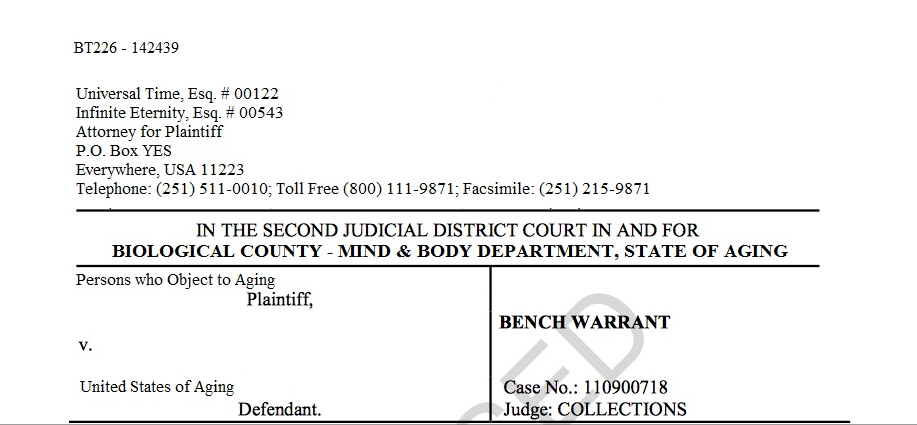
In the above court case, “Persons who Object to Aging v. United States of Aging” plaintiffs filed this action challenging the Aging’s Executive Order on natural processes. The People seek a finding that certain sections of the Executive Order are contrary to their desires to live forever, be young and abstain from societal objectification. Constitution and laws of the United States of Aging, and enjoining Defendants from implementing or enforcing those sections of the natural aging process. The People further seek entry of a nationwide temporary restraining order against all acts of aging – biological, social, cultural, internal and political. The judge presiding over the matter: Honorable Time, concludes “Before us today is present not a case of wanton and reckless behavior. Rather, we witness an unveiling of the beauty of time in all of its folds and uncertainties.” A bench warrant has been issued on the grounds of the written accusation of United States of Aging being guilty for a natural act. The case has been relegated to collections until further notice.
Seated in the courtroom, among a group of people diverse in ages and thoughts, you quickly rise to your feet and let out a screech, “Objection your Honor.” Also seated in the courtroom is Stevie Nicks who exclaims, “I want to be age appropriate. I don’t want to be that girl you see walking away and she looks 25 and then she turns around and she looks 90.”[1]
In an era that is ripe with resisting, anti-everything, detesting and protesting, perhaps we can find comfort in shared experiences. It may behoove us to seek out similarities rather than differences. Discussions in the courtroom among proponents of objecting to aging, are quick to rely on arguments that are toothless tigers. They quip, “Hey, objecting beats the alternative. You know, succumbing to the decay.” In the United States of Aging, no one wants to be seen waving their white flag, a symbol of surrender, and more pointedly, weakness. However, what if we change the script? And shift the meaning of what it means to be old. What if the images and the bodies of aging were more closely aligned with models in advertisements for Benetton?[2] On an individual level, how would a social and cultural aging situate the way people internalize their aging process?
 Perched on high, Honorable Time demands, “Please be seated.” Proponents of your objection turn the volume up on their snickering and clamor and the commotion and fracas crescendos until, “Order in the courtroom,” gruffly and vehemently reverberates among the walls from the booming voice of Honorable Time. Honorable Time delivers the verdict:
Perched on high, Honorable Time demands, “Please be seated.” Proponents of your objection turn the volume up on their snickering and clamor and the commotion and fracas crescendos until, “Order in the courtroom,” gruffly and vehemently reverberates among the walls from the booming voice of Honorable Time. Honorable Time delivers the verdict:
Today, we have been presented an incomplete case. It is unclear whether the plaintiff is requesting youth be on trial, the mind, the demeaning social inculcations of aging, the cultural misunderstandings of aging, or everyone else who does not object to aging. Therefore, it is in our dutiful interest, as a civilized United States of Aging, to further investigate the true and whole indecency of the quasi-crime presented before us today. At this point, it is paramount to understand the complexities and total gravity of the aging process and the social and cultural extensions of roots. I have not been convinced, beyond a reasonable doubt that aging is indeed a crime. I have heard witnesses from all sides, and yet it is still not clear to me how the plaintiffs would be satisfied in this situation.
Steven Tyler once wrote, “You have to lose to know how to win.”[3] In a similar vein, perhaps you need to be old to know how to be young. Or maybe old and young are purely made up categories that reinforce the social construction of certainty and uncertainty. As previously noted, perhaps it is time to write a different script on what it means to be old. The current working definitions of old, predate contemporary technologies and social categories. Prince concurs with his remarks on time. “Time is a mind construct.”[4] Times change. Minds change. Let us come together in our shared experiences. Rather than resist, give a hug. Hug yourself. Hug your old self. Hug your young self. Old and young are constructs. To the sun, we are all young.
Adrienne Ione is a cognitive behavioral therapist and personal trainer who integrates these fields in support of people thriving across the lifespan. As a pro-aging advocate, she specializes in the self-compassion of dementia.
Website: yes2aging.com
Guided Meditations: insighttimer.com/adrienneIone
Facebook: silverliningsintegrativehealth
References
[1] Stevie Nick did not actually appear in this hypothetical courtroom. Rather, her comment was from an interview that appeared in Rolling Stone.
[2] For an example of United Colors of Benetton advertisements, please visit Benetton.com
[3] Steven Tyler, American singer-songwriter for Aerosmith, wrote these lyrics for “Dream On.”
[4] Dorian Lynskey, “Prince: ‘I’m a musician. And I am music.’” The Guardian (June 23, 2011).

